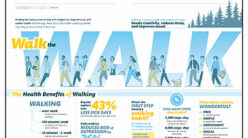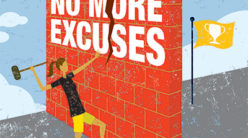If last names had anything to do with predisposing one to a sport, I guess this would be mine. Although swimming, bicycling, snowshoeing, roller skating, ice skating, and cross-country skiing also fall under the “volkssport” heading, walking is the main event, and the majority of volkssporting events are organized walks (the walking segment is sometimes referred to as volksmarching).
Volkssporting has been around since the mid-1960s. When some people in Europe looked around for a noncompetitive type of outdoor sport that anyone of any age could participate in, they couldn’t find one. So they invented one. They called it “volkssporting,” which in German means “a sport for the people.”
Volkssporting went global under the International Federation of Popular Sports, which promotes volkssporting throughout the world. The American Volkssport Association (AVA) was formed by Americans who traveled to Europe. They knew a good thing when they saw it and brought the sport back to America. The AVA’s mission is to promote health, fun, and fellowship by providing noncompetitive walking and other sporting events for everyone. It’s a real community sport, and many civic groups, service organizations, and volunteers work together to put on events.
“One of the things I really love about volksmarching is the camaraderie and support,” says Elaine Brayton, president of the Happy Wanderers in Daytona, Florida. “You get to meet people from all over. This week a group is coming from Nova Scotia, and they will be participating in four walks with us.”
Local clubs organize walks all through the year, many of them at scenic or historic sites. “I was a history major in college,” recalls Ron Hammer, of the Pentagon Pacesetters, “and one of the things I enjoy most about volksmarching is the historical aspect. A lot of volksmarches are planned at historical sites, and you can experience the history of the place from the ground level.”
Trails are carefully laid out and marked. If marking isn’t allowed, detailed maps are created. Trails are rated from 1 to 5, depending on how challenging they are. The designated start point stays open for several hours so you can begin whenever you want.
Checkpoints along the way are patrolled for security and safety. Most of the walks are 10 kilometers (6.2 miles). You will see groups and families participating, as well as the elderly and physically challenged. Anybody can volkssport.
Although it is noncompetitive, volkssporting provides incentive through an individual achievement program. This program provides a means to measure individual goals and promotes continued participation in volkssporting. At the events participants can purchase record books for a nominal fee. The purchase price pays for enrollment in the program, awards processing, and an award pin, patch, and certificate for each level of achievement. A credit stamp from the international organization is placed in your book when you complete each event. The program is strictly voluntary, however. Unless you want to sign up for the award program, there is no charge to participate.
Volkssporting has become so popular that the number of sanctioned events jumped from 200 in 1981 to more than 3,075 in 1998. In the United States alone more than 4 million people have taken part in volkssporting events and found a whole different kind of walk.
As a sport, walking didn’t used to get much respect as a “real” sport any more than, say, breathing would. But times they are a-changing. Eleven years after Walking magazine made its debut, “fitness walking has become the most popular physical activity in the nation, with 14.5 million regular participants,” according to American Sports Data Inc., a Hartsdale, New York, sports and fitness research company.
Walking magazine’s editor at large, Mark Fenton, lists five reasons that walking is America’s favorite exercise: It’s easy, effective, enjoyable, economical, and empowering.
“We get loads of letters from people who say, `Walking changed my life,'” he says. “Often they’ll say that when they started out, they could barely walk for 10 minutes, and now they walk in 10K races. Mostly, they tell us how walking’s helped them feel better and look better.”
The nice thing about walking as an exercise is that it doesn’t cost anything; you don’t need any special, expensive equipment; and you can do it anywhere, anytime. It has something to offer every age group. But is it a bona fide workout?
Maggie Spilner, walking editor for Prevention magazine, claims that it doesn’t have to be. “If your goal is to walk for health, then your walk doesn’t have to be a grueling workout.” Spilner says the surgeon general advises participating in at least 30 minutes of moderate activity every day. “That 30 minutes can be broken into three 10-minute sessions. The novice is often discouraged by the thought of walking for 30 minutes,” Spilner says. Her suggestion: “Start slow, and don’t worry too much about form in the beginning. Just get out and walk. . . . You’ll find you will do it more often, more easily.”
Participating in organized volks-sporting walks is a great way to meet other walkers. It’s also a made-for-family sport that encourages togetherness and gives you a chance to spend good old-fashioned quality time with your children, where no television, radio, or computer can intrude. And in today’s world that kind of time is a priceless commodity.







1 thought on “Volkssporting: A Whole New Kind of Walk”
lilly
(June 21, 2010 - 8:11 am)This is a great and fun sport! I’d like to try this with my friends.
Comments are closed.